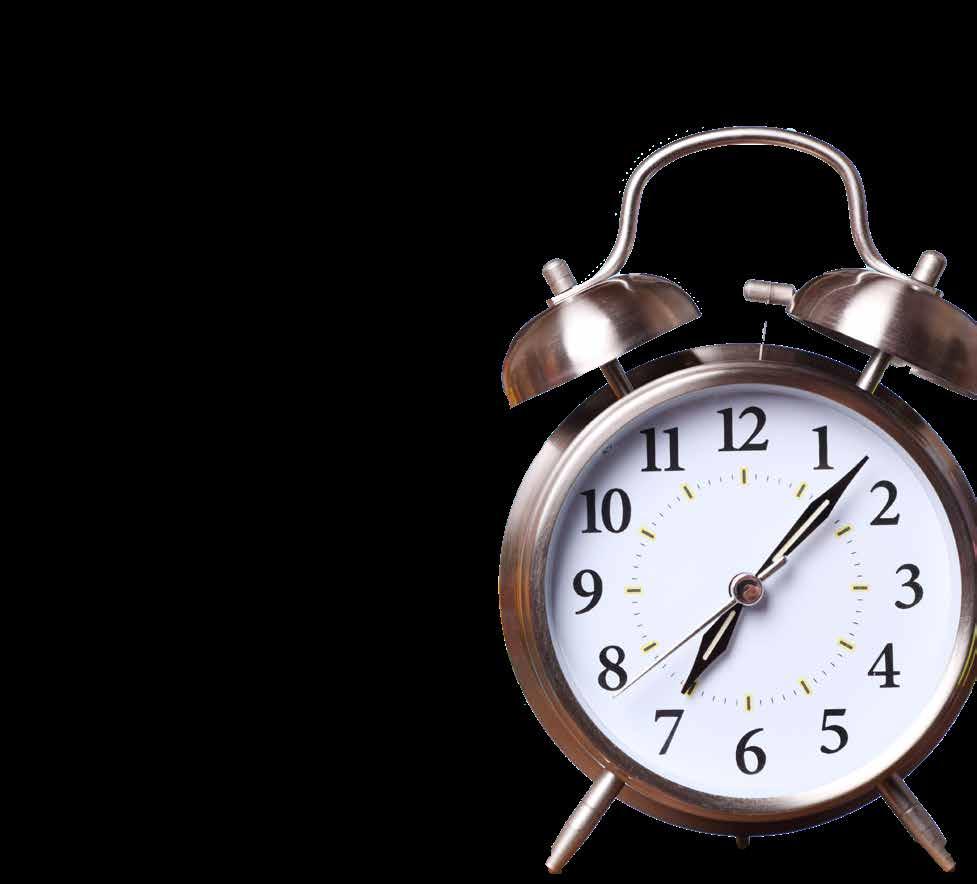
4 minute read
Daylight Saving Time An Idea Whose Time Has Come & Gone
By Jeanne Davant
Have you ever wondered why we set our clocks back every fall and turn them forward every spring?
Advertisement
Most people think Daylight Saving Time (DST) is an American invention, but it actually began in under Bay, Canada, in 1908. e residents of that small Ontario town set their clocks forward one hour at midnight on July 1 that year. By doing so, they gained an extra hour of light in the evenings. ey turned their clocks back an hour on September 1 so there would be more light in the mornings.
It is not known where they got the idea — contrary to widely held belief, Benjamin Franklin did not invent it, but someone in under Bay might have learned that George V. Hudson, an entomologist in New Zealand, proposed turning the clocks forward two hours in the spring. Hudson advanced the idea in a paper he presented to the Wellington Philosophical Society in 1895, suggesting that the time shift would better match the sunshine hours to the time people were awake. And it would give him more time to collect bugs.
Ten years later, in 1905, British construction tycoon William Willett, advanced the idea of turning clocks ahead by 80 minutes over four weeks in April; 20 minutes each Sunday, and reversing the process on the four Sundays in September. Willett led a campaign in the British Parliament, and bills were introduced several times in 1908 and 1909, but Daylight Saving Time did not become law until 1916, a year after Willett’s death.
Germany and Austria were the rst countries to adopt Daylight Saving Time, just weeks before the legislation passed in London. Europe was embroiled in World War I at the time, and the one-hour time shift helped to conserve electricity and fuel that was needed for the war e ort.
e United States followed suit on March 31, 1918, but Daylight Saving Time was repealed a year later. Legislators came under pressure from the farming industry. Again, contrary to widespread belief, farmers found the changes disruptive — it throws o harvesting schedules. However, Daylight Saving Time was restored nationally during World War II, from 1942 to 1945.
Many localities, though, kept up the practice after the war. Over the next 21 years, states, cities, and towns adopted and set their own start and end times for Daylight Saving Time. e result: One could pass through multiple di erent time zones traveling from one state to another in just one day.
In 1966, Daylight Saving Time was standardized by the passage of the Uniform Time Act, but there are still holdouts. Hawaii and Arizona, as well as several U.S. territories, do not participate.
Daylight Saving Time now is the rule in more than 70 countries and a ects more than a billion people.
Not everyone likes Daylight Saving Time. Opponents say that it does not save as much energy as it is purported to save. One study, conducted in southern Indiana in 2008 by the National
1895 1905
Entomologist George V. Hudson suggests “spring forward” to better match sunlight hours to the hours people were awake. Construction tycoon William Willett suggests "spring forward" over four weeks in April.
1908 1916
Bill introduced to British Parliament. Residents in Thunder Bay, Canada begin implementing DST to gain extra sunlight. Germany and Austria adopt DST, followed within weeks by Britain.
1918
A law is passed in the United States to implement DST.
1919
The U.S. law is repealed.
Bureau of Economic Research, used data from electric bills to conclude that energy use actually increased slightly during its use. ere’s also evidence that Daylight Saving Time can a ect people’s health. Studies have noted an increase in tra c accidents, injuries in the workplace, heart attacks, suicides, and miscarriages at the beginning of the change, when people lose sleep and circadian rhythms can be disrupted. And those prone to depression may su er more when it ends. Parents of children whose school day starts early in the morning are not fond of taking them to school in the dark.
Proponents of Daylight Saving Time note that there are positive e ects as well. In some areas like Germany, studies have found that, at some latitudes, it leads to energy savings. Other studies have determined that it may contribute to better health by motivating people to get outside more.
Daylight Saving Time remains controversial in the United States. Some people would like to make it year-round, while others want to abolish it completely. In fact, a bill to make Daylight Saving Time permanent was introduced in Congress in 2022 and is still under consideration. So, for the time being, we will continue to go through the twice-a-year ritual of “spring forward, fall back.”

19421945
The U.S. 1918 law is restored during WWII to save electricity and gas consumption.
1966
DST is standarized throughout the U.S. through the Uniform Time Act.
PRESENT
DST is observed by 70 countries, affecting more than one billion people.





